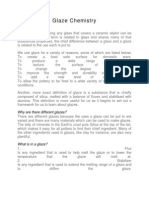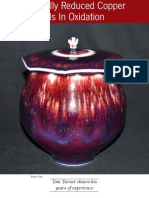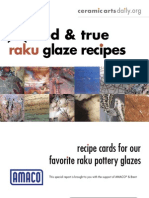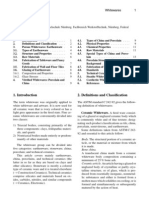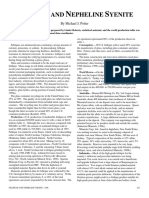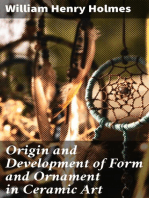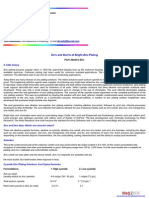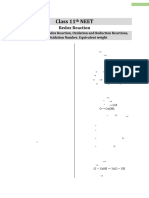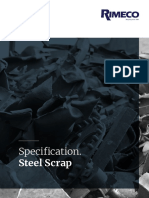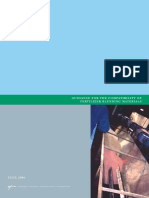Basic Info About Glaze Formulations
Basic Info About Glaze Formulations
Uploaded by
ThongMaVanCopyright:
Available Formats
Basic Info About Glaze Formulations
Basic Info About Glaze Formulations
Uploaded by
ThongMaVanCopyright
Available Formats
Share this document
Did you find this document useful?
Is this content inappropriate?
Copyright:
Available Formats
Basic Info About Glaze Formulations
Basic Info About Glaze Formulations
Uploaded by
ThongMaVanCopyright:
Available Formats
Basic Info about Glaze Formulations:
Ceramic glazes generally contain silica to form glass, in combination with a mixture of metal oxides such as sodium,
potassium and calcium which act as a flux and allow the glaze to melt at a particular temperature, alumina (usually from
added clay) to stabilize the glaze and prevent it from running off the piece, colorants such as iron oxide, copper
carbonate or cobalt carbonate, and sometimes opacifiers such as tin oxide or zirconium oxide.
FLUXES:
Barium Oxide Na
2
)
Potassium Oxide K2O
Lithium Oxide Li
2
)
Calcium Oxide CaO
Magnesium Osice MgO
Zinc Oxide ZnO
Strontium Oxide SrO
STABILIZERS
Aluminum Oxide (Alumina) Al
2
O
3
Boric Oxide B
2
O
3
Iron oxide Fe
2
O
3
GLASS FORMERS
Silicon Dioxide (Silica) SiO
2
Wgt % VS Seger Unity (molar composition)
So, dont freak out herethis is just to expose you to the basics of glaze chemistry. We will be working with
glaze recipes. If you want to work on the Unity formula of a particular glaze, we can do that.
The weight % glaze formulas describe how to mix the glaze; it provides you with little information upon
which to compare 2 glazes, or predicting the stability of a glaze.
EXAMPLE (from Mastering Cone 6 Glazes, John Hesselberth & Ron Roy, 2002)
Jade Green, Cone 4 - 6
Glaze Recipe Unity Formula
Potash Feldspar 40.0 Fluxes
Barium Carbonate 20.0 K
2
O 0.127
Gerstley Borate 10.0 Na
2
O 0.080
Zinc Oxide 9.9 CaO 0.138
EPK 10.1 MgO 0.041
Silica 10.0 Li
2
O
100.0 ZnO 0.336
Add
Copper Carbonate
5.25
BaO 0.278
Stabilizers
Al
2
O
3
0.295
B
2
O
3
0.157
Glass Formers
SiO
2
2.011
Si:Al 6.5
The left side of the table shows us how to mix the glaze, but it tells us nothing of the composition. On the right
hand side of the table, the level of silica (SiO
2
) level of 2.001 violates the first rule of making stable glazes and
indicates instantly this glaze is likely to be unstable. Testing shows you need a unity formula of at least 3.0 SiO
2
and above to produce a stable glaze. Indeed, the Jade Green is found to easily leach copper and barium from
the glaze in an acidic environment.
WEIGHING THE GLAZE MATERIALS
Clean and Tare the scale
Have a good check list avoid interruptions
Wear a face mask / respirator / protective lenses / gloves
MIXING GLAZES:
Dry mix: try not to raise too much dustplease wear respirator / eye protection
Always add powder to water (approx. 90 ccs water per 100 grams of dry glaze mix, i.e., 8000 gram
recipe should take about 1.9 gallons (7.6 Qts) of water.
Dont add dry glaze too fast (dont let it accumulate into a pile on top of the water. Let it sit. Powder
should be completely wetted.
Initial mixing can be done with a spoon, stir stick.
Screen / sieve thru 80 mesh. Some recommend doing this twice, and again before each use.
Dip test with a bisqued shard. Scratch thru and visually examine the thickness of application. If glaze is
a translucent/runny glaze, should be less than 1/16 of an inch thick. Most others no more than 1/16 of
an inch
Specific Gravity: Should be about 1.45 gms/cc. An easy way to measure this is to weigh a container (1 C.
will do) = W
1
; measure and add 100 cc of your glaze. Reweigh = W
2
. Determine Gms/CC = W
2
W
1
/
100 If your Specific Density is greater than 1.45 gms/cc, add more water. If it is less, let the glaze sit
overnight, settle, and carefully remove excess water from top of glaze.
TESTING GLAZES for durability, longevity, safe usage.
Resistance to Acids insert half test tile in vinegar for 3 days. Goal is no color change/bleaching
Resistance to Alkalis (usually in dishwasher) - 5% soda ash (50 gms soda ash in 1 Liter of water), in
stainless steel pot, bring to a boil, reduce to simmer gently. Put in pan, cover, simmer gently for 6 hours.
= 250 cycles in a dishwasher . Goal is no color change
Resistance to Thermal Shock Freeze piece for 2 hrs, then carefully place in boiling water. Look for
cracking, crazing, shivering. Use black ink to bring out cracking. Compare with non-exposed sample.
Microwave Oven proof place test mug in boiling water & let it simmer for 2 hrs (absorbs as much
water as is possible). Take another mug, fill with water. Place both test mug and filled mug in
microwave and nuke on high for 10 seconds (no more). Open carefully. If your test piece is too hot to
handle, it is NOT microwave safe. It is important when conducting this test to have the mug of water
present in the test as you could otherwise damage your microwave.
GLAZE TRIAL BLENDS
Using Existing Glazes
Overlap: 2 Glaze overlaps: Dip one glaze covering most of test tile. Dry. Dip second glaze over 50% of
test tile.
Dry Blends: Using 30 gm quantities of base glaze, add known % of oxides
Wet Blend: Use 2 existing glazes (wet), try blends of 25:75, 50:50, 75:25
Using Base Glazes
Select a base glaze recipe: Matte, Semi-matte, Glossy
Dry Blends: Using 30 gm quantities of base glaze, add known % of oxides. With small quantities, you
must be VERY accurate in weighing the oxides. Recommended amount ranges:
Cobalt Oxide or Carbonate - 1%
Iron Oxide 1 10%
Copper Oxide or Carbonate 2 5%
Chrome 2 5%
Nickel - 3%
Manganese 2 6%
Vanadium Stain 4 10%
Rutile 2 10%
Ilmenite 1 5%
Line Blends / Tri-axial Blends: See Rhodes, Clay and Glazes for the Potter, 1967, Pg 136 - 138
Pg 138 provides a color description of oxide combinations.
Pgs 127 134 provides information on specific oxides.
As well as About.com Pottery Ceramic Glaze Colorants
Wikipedia Ceramic Colorants
General Resources:
Glaze Chemistry (Ceramic Arts Daily
Mid Range Glaze Recipes (Ceramic Arts Daily)
Glossary of terms (Ceramic Arts Daily)
Ceramic Colorants (Ceramic Arts Daily)
Mason Stains Color Charts
MSDS (Material Safety Data Sheets)
You might also like
- CAD159 LowFireGlazes 11°Document20 pagesCAD159 LowFireGlazes 11°Maria Auxiliadora Rodriguez100% (1)
- AASHTO M 270 Grade Steel PDFDocument14 pagesAASHTO M 270 Grade Steel PDFarunjacobnNo ratings yet
- Aluminium Cleaner and Polisher Formulations and Production ProcessDocument7 pagesAluminium Cleaner and Polisher Formulations and Production ProcessRohullah Baqiri100% (4)
- Ceramic Glazing for Beginners: What Every Ceramic Artist Should Know to Get Better GlazesFrom EverandCeramic Glazing for Beginners: What Every Ceramic Artist Should Know to Get Better GlazesRating: 3 out of 5 stars3/5 (5)
- Self Reliant Potter GLAZES You Can MakeDocument162 pagesSelf Reliant Potter GLAZES You Can MakeStefan Van Cleemput100% (3)
- Glazes and Glazes CoatingDocument343 pagesGlazes and Glazes CoatingMar Yam82% (11)
- Creating A EngobeDocument105 pagesCreating A Engobeduyen nguyen chi luongNo ratings yet
- Crystalline Glaze Class Dan DermerDocument4 pagesCrystalline Glaze Class Dan DermerJesus MorenoNo ratings yet
- Glaze ChemistryDocument9 pagesGlaze ChemistrydtkraeutNo ratings yet
- STA Decorating SlipDocument2 pagesSTA Decorating SlipmohanNo ratings yet
- Ceramic ColorDocument12 pagesCeramic ColorMeisterFidiusNo ratings yet
- Will Schran Cone 6 Crystals PDFDocument4 pagesWill Schran Cone 6 Crystals PDFjaguilar333No ratings yet
- Copper Red - Chemical ReductionDocument8 pagesCopper Red - Chemical ReductionAlexandre Oliveira100% (1)
- Greenwich House Pottery Clay and GlazeDocument18 pagesGreenwich House Pottery Clay and GlazeMohammad Youssefi100% (2)
- Glazes - For The Self-Reliant Potter: Appendix: Glaze RecipesDocument21 pagesGlazes - For The Self-Reliant Potter: Appendix: Glaze RecipesgeertjepNo ratings yet
- Core Practical 15: Analyse Organic and Inorganic Unknowns: ChemistryDocument8 pagesCore Practical 15: Analyse Organic and Inorganic Unknowns: ChemistryFan Annika100% (1)
- Introduction To Glaze CalculationDocument4 pagesIntroduction To Glaze CalculationThongMaVanNo ratings yet
- Material Substitutions For Clay BodiesDocument11 pagesMaterial Substitutions For Clay BodiesGreg CampbellNo ratings yet
- Self Reliant PotterDocument116 pagesSelf Reliant PotterYaroslav MatviychukNo ratings yet
- Ceramic FritsDocument6 pagesCeramic FritsMohammad YoussefiNo ratings yet
- 08 Chapter 4Document8 pages08 Chapter 4Ali AliNo ratings yet
- Glazed CeramicsDocument7 pagesGlazed CeramicsPablo Cesar Reyes AmadorNo ratings yet
- Ceramic: For Other Uses, See - A Ceramic Is An, NonmetallicDocument7 pagesCeramic: For Other Uses, See - A Ceramic Is An, Nonmetallicletter_ashish4444No ratings yet
- CeramicColor PDFDocument12 pagesCeramicColor PDFSiddharthapachisiaNo ratings yet
- Ceramic FritsDocument2 pagesCeramic Fritslaklain100% (1)
- Esmaltes Varios en Inglés FABIDocument8 pagesEsmaltes Varios en Inglés FABIclaul66100% (1)
- Ceramics: Windows To The FutureDocument75 pagesCeramics: Windows To The FuturevishwanathanskNo ratings yet
- Advanced Ceramics SyllabusDocument4 pagesAdvanced Ceramics Syllabusapi-285550989No ratings yet
- Clay and Glaze MaterialsDocument28 pagesClay and Glaze Materialsapi-26965779100% (2)
- Stoneware MaturityDocument3 pagesStoneware MaturityLNo ratings yet
- Firing Without Signup and A Kiln Chart May Be Turned Off! Plan To Unload Your Kiln by 2Document5 pagesFiring Without Signup and A Kiln Chart May Be Turned Off! Plan To Unload Your Kiln by 2stueferNo ratings yet
- Workshop Handbook Ceramics PDFDocument25 pagesWorkshop Handbook Ceramics PDFperdidalma100% (1)
- 43vocabulary Basic CeramicsDocument6 pages43vocabulary Basic CeramicsReshmi VarmaNo ratings yet
- PotteryDocument12 pagesPotterybaby_dygqu90100% (1)
- Pottery PrimerDocument194 pagesPottery Primerflava71100% (1)
- Ceramic SpectrumDocument5 pagesCeramic SpectrumMaria Auxiliadora RodriguezNo ratings yet
- Firing Temperatures: & Cone EquivalentsDocument2 pagesFiring Temperatures: & Cone EquivalentsIcy45100% (1)
- The Upside - Down Bowl: by Martina LantinDocument4 pagesThe Upside - Down Bowl: by Martina LantinParaSemore Vivendo100% (1)
- Roger GrahamDocument3 pagesRoger GrahamStefan Van CleemputNo ratings yet
- Raku Firing TechniquesDocument19 pagesRaku Firing Techniquesduyen nguyen chi luongNo ratings yet
- 15 RakuglazesDocument9 pages15 Rakuglazespotteryart54No ratings yet
- Electric KilnsDocument16 pagesElectric KilnsMadalina Teler100% (2)
- Introduction To CeramicsDocument29 pagesIntroduction To CeramicsShrikrishna BirajdarNo ratings yet
- White Wares by K-H SchullerDocument17 pagesWhite Wares by K-H SchullerChuff123No ratings yet
- Staying TrimDocument4 pagesStaying TrimStefan Van CleemputNo ratings yet
- Salt Glaze SurfaceDocument11 pagesSalt Glaze SurfaceStefan Van Cleemput100% (3)
- Clay and GlazesDocument252 pagesClay and Glazescyberkike100% (2)
- 15 Cone 10 RecipesDocument10 pages15 Cone 10 RecipesInga NowakNo ratings yet
- Ceramics GlossaryDocument91 pagesCeramics GlossaryMohammad Youssefi100% (1)
- Ceramics Monthly (June 1959)Document44 pagesCeramics Monthly (June 1959)Wade MacMorrighan100% (2)
- CerartsantoDocument6 pagesCerartsantoLucia Sueli Taguchi100% (1)
- FeldsparDocument7 pagesFeldsparRiChy KantuNo ratings yet
- Large Pots - Bill ShinnDocument4 pagesLarge Pots - Bill ShinnStefan Van Cleemput100% (2)
- How To Fire Pottery and Ceramics - How To Fire A Kiln - and Kiln Firing Techniques - HubPagesDocument6 pagesHow To Fire Pottery and Ceramics - How To Fire A Kiln - and Kiln Firing Techniques - HubPagesCAMELIA Neagu-COGALNICEANUNo ratings yet
- Preparing & Storing GlazeDocument4 pagesPreparing & Storing GlazeGianmarcoMolinaNo ratings yet
- Ceramics Monthly Jan53 Cei0153dDocument36 pagesCeramics Monthly Jan53 Cei0153dLitto Ferel100% (2)
- Ceramic Vocabulary ListDocument3 pagesCeramic Vocabulary ListVioh NguyenNo ratings yet
- CeramicsDocument45 pagesCeramicsJohn Achilles Ricafrente100% (1)
- The Potter's Craft: A Practical Guide for the Studio and WorkshopFrom EverandThe Potter's Craft: A Practical Guide for the Studio and WorkshopNo ratings yet
- Origin and Development of Form and Ornament in Ceramic ArtFrom EverandOrigin and Development of Form and Ornament in Ceramic ArtNo ratings yet
- A Study of CA-Mg Silicate Crystalline Glazes - An Analysis On Forms of CrystalsDocument5 pagesA Study of CA-Mg Silicate Crystalline Glazes - An Analysis On Forms of CrystalsThongMaVanNo ratings yet
- Journal of Materials Science 47 (2012) 553-582Document53 pagesJournal of Materials Science 47 (2012) 553-582ThongMaVanNo ratings yet
- Carty Nceca 2012Document23 pagesCarty Nceca 2012ThongMaVanNo ratings yet
- Chapter 02Document31 pagesChapter 02ThongMaVanNo ratings yet
- 9 Studyofheatdistr08bleiDocument52 pages9 Studyofheatdistr08bleiThongMaVanNo ratings yet
- 9.FinalBrick.11Aprl Print VersionDocument164 pages9.FinalBrick.11Aprl Print VersionThongMaVanNo ratings yet
- Precipitation Titration 1Document25 pagesPrecipitation Titration 1Beyond LbbNo ratings yet
- P - Block ElementsDocument47 pagesP - Block ElementsJaipratap SinghNo ratings yet
- The Use of High Temperature Processing HTP Steel F PDFDocument7 pagesThe Use of High Temperature Processing HTP Steel F PDFCoca CocaNo ratings yet
- EQA-Industrial-Effluent 5th-ScheduleDocument2 pagesEQA-Industrial-Effluent 5th-Scheduleraman.kNo ratings yet
- Ironmaking and SteelmakingDocument15 pagesIronmaking and SteelmakingVijay KumarNo ratings yet
- Practise Paper For Final Exam SLDocument17 pagesPractise Paper For Final Exam SLroro mc gillNo ratings yet
- Elimination of Cadmium From Wet Process Phosphoric Acid With Alamine 336 - ScienceDirectDocument5 pagesElimination of Cadmium From Wet Process Phosphoric Acid With Alamine 336 - ScienceDirectHaseeb ChaudharyNo ratings yet
- CHM1 Q1 0902 FDDocument26 pagesCHM1 Q1 0902 FDDumalay, Xenia L.No ratings yet
- Synthesis of Cobalt ComplexDocument6 pagesSynthesis of Cobalt ComplexRenniel Pena100% (1)
- Electron Arrangement Y10Document10 pagesElectron Arrangement Y10Iftitahur Rohmah -No ratings yet
- Chemistry F4Document12 pagesChemistry F4Erick SiameNo ratings yet
- Bright Zinc PlatingDocument3 pagesBright Zinc PlatingHacı OsmanNo ratings yet
- CHEM131 ElectrochemistryDocument38 pagesCHEM131 ElectrochemistryAngel Rose AriasNo ratings yet
- Sec1 Sci c7p Eq 2nd 61marks 4studentsDocument14 pagesSec1 Sci c7p Eq 2nd 61marks 4studentsKamasha BabaNo ratings yet
- WS Grade 9 IG Chemistry 22-23 - Extraction of Metals and StoichiometryDocument3 pagesWS Grade 9 IG Chemistry 22-23 - Extraction of Metals and StoichiometrySiyaNo ratings yet
- Redox 0.2 QuestionDocument11 pagesRedox 0.2 Questionshubham31870No ratings yet
- Class 12 Chemistry Practical FileDocument27 pagesClass 12 Chemistry Practical FileShibani SenthilbabuNo ratings yet
- ISO 5794Document6 pagesISO 5794umtnztNo ratings yet
- Flame Tests and Spectroscopy Lab. C.S.Document3 pagesFlame Tests and Spectroscopy Lab. C.S.jahajaha_svensson609No ratings yet
- COORDINATION COMPOUNDS - Class Notes - JEE MindmapDocument22 pagesCOORDINATION COMPOUNDS - Class Notes - JEE Mindmapadsaditya24No ratings yet
- Specification.: Steel ScrapDocument24 pagesSpecification.: Steel ScrapKalpeshNo ratings yet
- 9631u G JSD 1300 0021 3Document18 pages9631u G JSD 1300 0021 3Utku KepcenNo ratings yet
- Guidance For The Compatibility of Fertilizer Blending Material PDFDocument16 pagesGuidance For The Compatibility of Fertilizer Blending Material PDFKate RyncaNo ratings yet
- Formula SprayDocument3 pagesFormula SprayW Mega0% (1)
- G2 4-G2 4M-2014Document58 pagesG2 4-G2 4M-2014Peter Lopez67% (3)
- Sulfanilamide Synthesis 2Document2 pagesSulfanilamide Synthesis 2Arindam DasNo ratings yet
- WORKSHEET - Reactivity & Rate of Chemical Reaction - ANSWERDocument5 pagesWORKSHEET - Reactivity & Rate of Chemical Reaction - ANSWERKevin ImmanuelNo ratings yet









